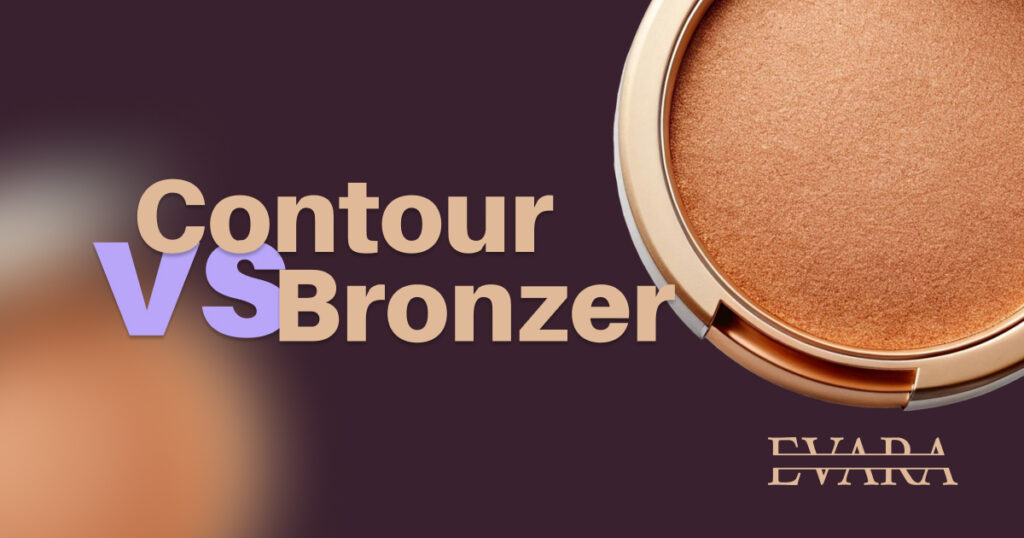
✨ Contour vs. Bronzer: What’s the Difference, How to Use Them, and How to Choose the Right Products
💡 The Basic Difference:
Contour is about creating shadow and structure — sculpting the face, defining bone structure, and adding depth.
Bronzer is about adding warmth, sun-kissed glow, and color — making the skin look healthier, warmer, and more radiant.
🗺️ Think of It Like This:
Contour = Shadow.
“Where would natural shadows fall on the face?”
Bronzer = Sun.
“Where would the sun naturally hit to warm your face?”
🔥 What Each One Does:
▶️ Contour:
- Mimics natural shadows.
- Defines cheekbones, jawline, nose, and forehead.
- Slims, sharpens, and sculpts.
▶️ Bronzer:
- Adds warmth and glow.
- Makes you look healthy, sun-kissed, and less flat.
- Softens and blends, balancing out contour or adding warmth even without it.
🎨 Tone & Undertones — How to Choose the Right Shade:
▶️ Contour Shades:
- Cool-toned or neutral-cool — because real shadows are greyish, not orange.
- Avoid anything too warm — that’s bronzer territory.
- For fair skin: taupe-based.
- For medium skin: neutral brown with a hint of grey.
- For deep skin: deep, rich browns with neutral or olive undertones (not red-orange).
✅ Rule: If it looks muddy, it’s too dark. If it looks orange, it’s too warm (wrong for contour).
▶️ Bronzer Shades:
- Warm undertones — golden, honey, or terracotta.
- Designed to mimic a tan or warmth.
- For fair skin: soft peachy-tan or golden beige.
- For medium skin: warm golden, caramel, or rich terracotta.
- For deep skin: rich chocolate, warm espresso, or reddish-brown with golden undertones.
🧴 What Products to Use — Cream or Powder?
🔸 Contour:
Cream: More natural, melts into the skin, great for dry skin or dewy looks.
Examples: Fenty Match Stix, Charlotte Tilbury Contour Wand, Anastasia Contour Stick.
Powder: More defined, great for oily skin or matte finishes.
Examples: Kevyn Aucoin Sculpting Powder, KVD Shade + Light Palette.
🔸 Bronzer:
Powder: Classic, easiest to blend over powder foundation or set skin.
Examples: Benefit Hoola (cooler for bronzer), NARS Laguna, Fenty Sun Stalk’r.
Cream/Liquid: Fresh, radiant, very natural.
Examples: Chanel Les Beiges Healthy Glow, Rare Beauty Warm Wishes, Saie Sun Melt.
📍 Where to Apply — Placement Matters:
▶️ Contour:
- Under cheekbones (find the hollow beneath your cheekbone).
- Jawline (to sharpen).
- Sides of the nose (if desired).
- Around hairline/forehead (if shaping).
🗝️ Think: Create depth where you want things to “push back” or recede.
▶️ Bronzer:
- Top of cheekbones, temples, forehead — “where the sun hits.”
- Across the nose for a sun-kissed vibe.
- Lightly on the neck to match the face warmth.
🗝️ Think: Warm the high points, not the hollows.
🎯 How to Choose — Quick Guide:
| Contour | Bronzer | |
|---|---|---|
| Purpose | Sculpt, define, create shadows | Warmth, glow, healthy color |
| Undertone | Cool, neutral-cool, taupe | Warm, golden, terracotta |
| Formula | Cream for natural, powder for sharp | Powder for easy, cream for dewy |
| Placement | Hollows — cheeks, jaw, nose | High points — cheeks, forehead, nose |
| Finish | Matte (never shimmer) | Matte, satin, or glowy |
🚫 Common Mistakes:
- Using bronzer as contour — leads to orange, muddy lines.
- Using contour as bronzer — makes the face look gray or dirty instead of warm.
- Wrong placement — contour on high points or bronzer in hollows.
✨ Pro Backstage Tip:
“On runway and editorial, we often use a mix. First, contour to create structure under harsh lights. Then bronzer to bring warmth back so the face looks alive — not flat or ghostly in photos.”
🔥 Conclusion: Contour sculpts. Bronzer warms.
You don’t have to use both every time — but knowing the difference changes the game.
Get the undertones right, and your makeup instantly looks more professional and balanced.